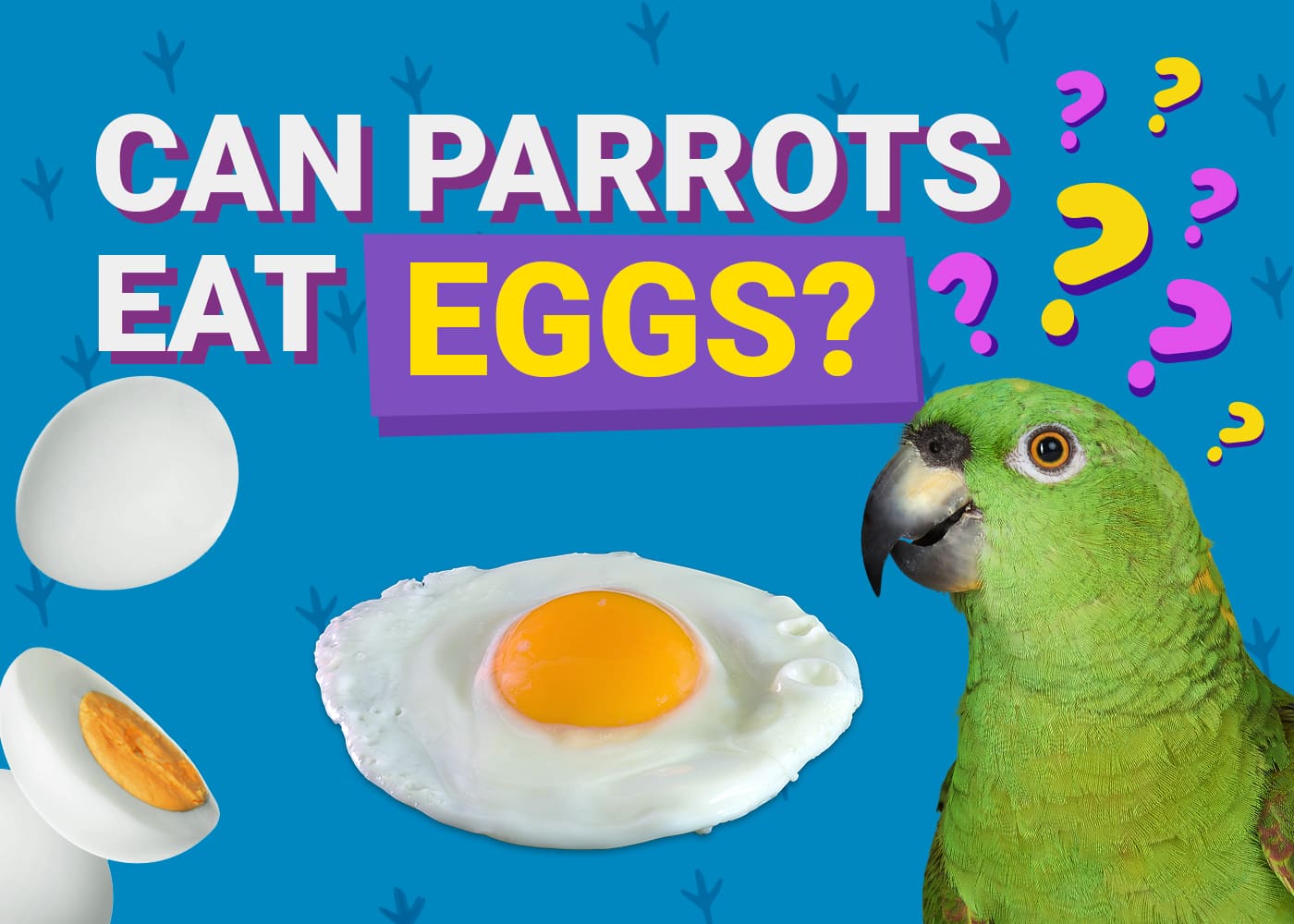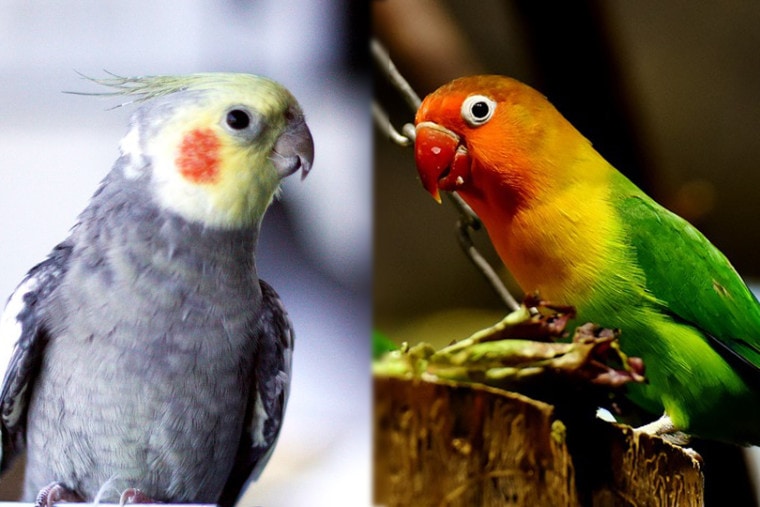
Most pet bird lovers love to keep different bird species. Whether you want to keep canaries, budgerigars, parrots, finches, lovebirds, or cockatiels, each bird species comes with different needs, temperaments, and characteristics.
If you want to diversify and keep multiple species, you need to understand that some of these birds don’t get along very well. While some breeds will live together harmoniously, others may be quite a challenge. Therefore, before devoting large portions of your home to bird cages, you need to know whether the bird species can co-exist.
Suppose you want to keep lovebirds and cockatiels; can they live together in one cage?
The simple answer is no, unless they are properly socialized as young birds. Keep reading to learn more!
 Lovebirds
Lovebirds
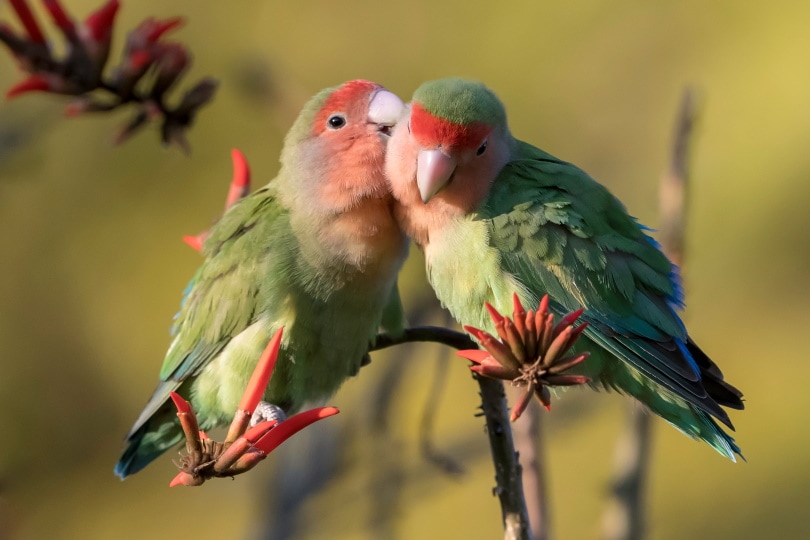
Lovebirds are one of the most popular pet parrot species. These beautiful and intelligent birds come in vibrant green or yellow colors with blue, pink, and orange highlights.
They are much smaller than cockatiels and much louder. Personality-wise, these birds are very active and aggressive and more likely to bully other birds.
Originally from the African continent, these birds are native to the savannas and forests of Sub-Saharan Africa and Madagascar.
These little parrots have nine different subspecies, each with distinct characteristics. They include the Fischer’s, Nyasa, masked, black-cheeked, Swindern’s, red-faced, Abyssinian, Madagascar lovebird, and peach-faced lovebird.
 Cockatiels
Cockatiels
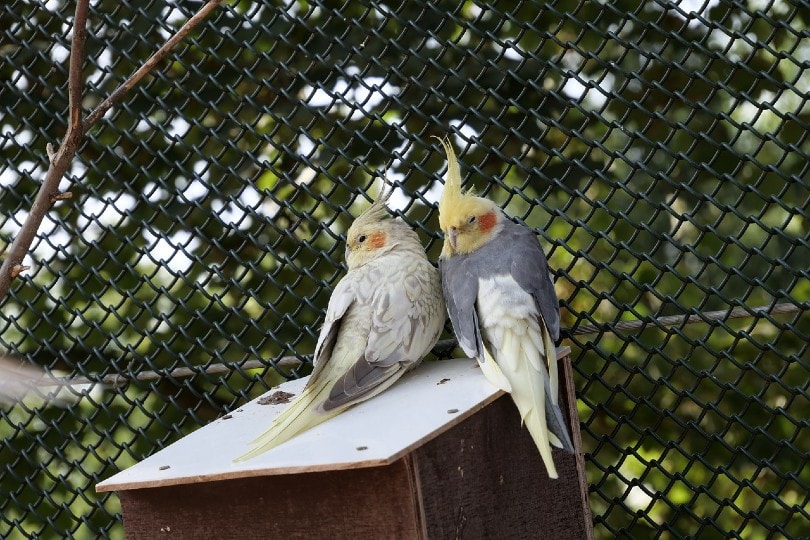
Cockatiels are small, grey birds with a movable crest, long tails, and white stripes on their wings. A native to Australia, they are one of the most popular pet birds on the market.
This small parrot-like bird is from the cockatoo family. Distinguishable by the prominent yellow crest on their head, they are available in white and different shades of greys.
Known for their friendly personalities, they also stand out with the yellow patches on their face in adult males. However, they have different mutations that determine color and pigmentation. The most common mutations are lutino cockatiels, albinos, white-faced, pied, cinnamon, and pearl.
If you’re new to the wonderful world of cockatiels, you’ll need a great resource to help your birds thrive. We highly recommend taking a closer look at The Ultimate Guide to Cockatiels, available on Amazon.
This excellent book covers everything from the history, color mutations, and anatomy of cockatiels to expert housing, feeding, breeding, and health care tips.
Can Lovebirds and Cockatiels Live Together in One Cage?
These two birds have different origins, temperaments, and characteristics. While the cockatiels are docile and friendly, lovebirds are aggressive and active.
Here’s why these two bird species can’t co-exist.
Lovebirds Tend to Be Aggressive
Aggression is very common with lovebirds. These parrots are territorial and will rarely get along with birds from another species.
Despite their small size, they can overpower the docile cockatiels and attack them by nipping their toes or bodies. They become jealous and hormonal during the mating season, where they attack other lovebirds as well.
This notorious behavior and meanness might not work well with your cockatiel; therefore, it’s better to keep them separate. When they get annoyed, they will bite much harder, making training this bird species quite a challenge.
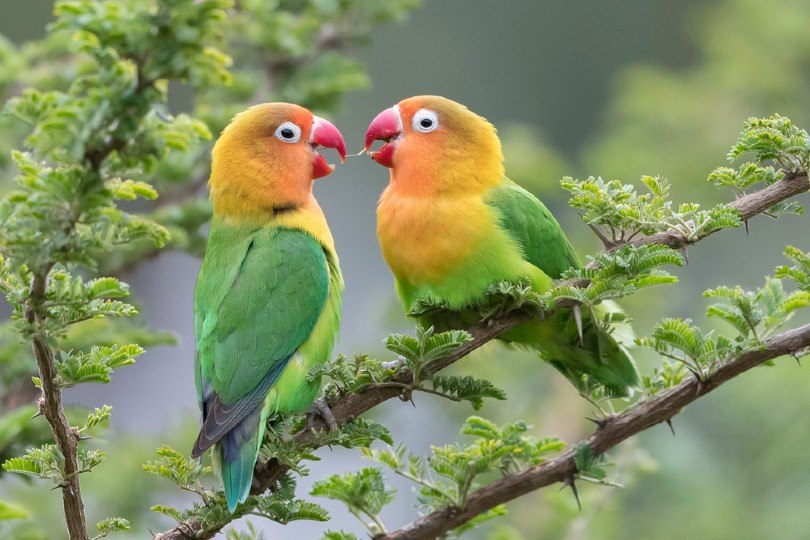
Lovebirds Are Very Active
Each bird, no matter the breed, needs enough space in the cage to play and jump. Therefore, if you are thinking of keeping multiple species, you have to consider space to add perches and ladders for your birds to play.
Like all parrots, lovebirds are extremely active birds. Because of this, they need a lot of exercise. Therefore, if you want to keep this bird and a cockatiel, you need to be prepared to buy two cages with enough space for each bird to play safely. With its own cage, the lovebird can exercise freely without feeling crowded.
However, if you put the two together, territorial problems will arise, leading to attacks and fights which could harm one of your birds.
Cockatiels Are Okay with Human Companionship
Cockatiels are social birds. They love getting attention from their caretakers and company. Since they love companionship, they are okay with human attention or company from a fellow cockatiel or other companionship birds.
Therefore, instead of pairing this bird with the aggressive lovebird, you can either devote some time to spend with your bird or get another cockatiel. In addition, these birds also appreciate their own time with you to avoid jealousy, therefore dedicate separate time for each bird and allow them to fly around outside the cage at different times.
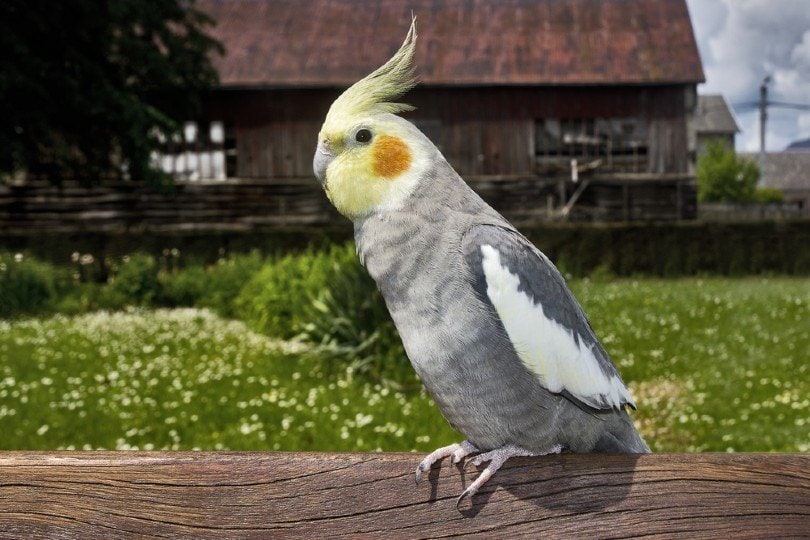
Both Birds Tend to Be Noisy
Cockatiels and lovebirds are extremely vocal. While they both can’t talk as well as other parrots, they mimic sounds such as whistles, doorbells, and telephones.
In addition, when they can’t get your attention or become agitated, they tend to be extra vocal. However, the lovebird is much louder and generates high-pitched shrieks.
Putting these two vocal birds in the same cage is room for disaster. They’ll engage in a screaming match to get your attention which can easily develop into a fight. To avoid such problems in your house, get each bird a different cage to watch each other from a distance.
What Factors Influence How Birds Live Together?
Before putting multiple bird species in a cage, you need to consider the following factors.
Size
The size of your birds really matters. When getting different bird species, you need to determine whether one is larger than the other one.
The presence of a larger bird could stress the smaller birds. Apart from body size, an essential aspect to look at is the beak size. Birds of the same size with similarly sized beaks will tend to get along much better.
Even though a bird species has a friendly personality, they’ll still attack the smaller birds or behave like a bully. When the birds are of similar size, they may establish a hierarchy, but they will be in a position to defend themselves from any attacks.
However, in the case of lovebirds and cockatiel, the lovebird is very aggressive despite being smaller than the cockatiel. Therefore, size shouldn’t be the only factor to consider.
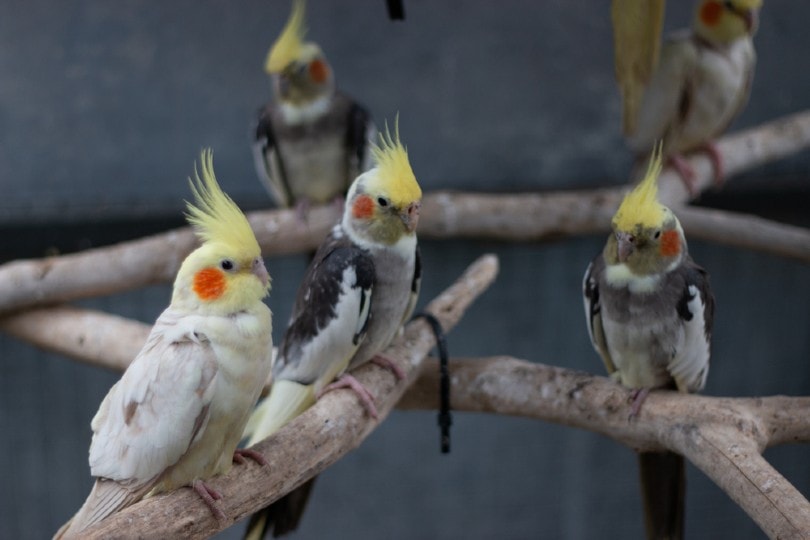
Age
Younger birds tend to get along with other species much better if they are introduced at an early age. Socialization comes to play if you want to have multiple pet birds.
The age at which the two species meet will determine how well they get along. For instance, if you bring a cockatiel and a lovebird to your home at the same time, they’ll have a better chance of living in harmony.
If you are planning to keep more than one species, let the pet birds interact when they are still young. Despite the different natural temperaments, they are more likely to remain friendly as they mature into adulthood. Early socialization is vital for the peaceful coexistence of most birds.
Temperament
It would be best if you researched beforehand which birds get along and what their temperaments are. Birds with the same personality, traits, and energy levels have a better chance of living peacefully than those with a completely different temperament.
For instance, cockatiels and lovebirds are both small birds. However, the lovebird is very aggressive and highly energetic. Because of this difference in personality, it’s more likely that the two birds will not get along.
Lovebirds are notoriously aggressive and should always be kept as single pairs.
In addition, some birds are known to be companion birds. For instance, if you have a cockatiel, they’ll perfectly live well with Bourke, scarlet-chested, princess, turquoise, and king parrots.
Also, birds such as parakeets are sometimes successfully housed together with cockatiels, but their size difference can be an issue. Before committing to any two birds, do your due diligence to make it easier for you.
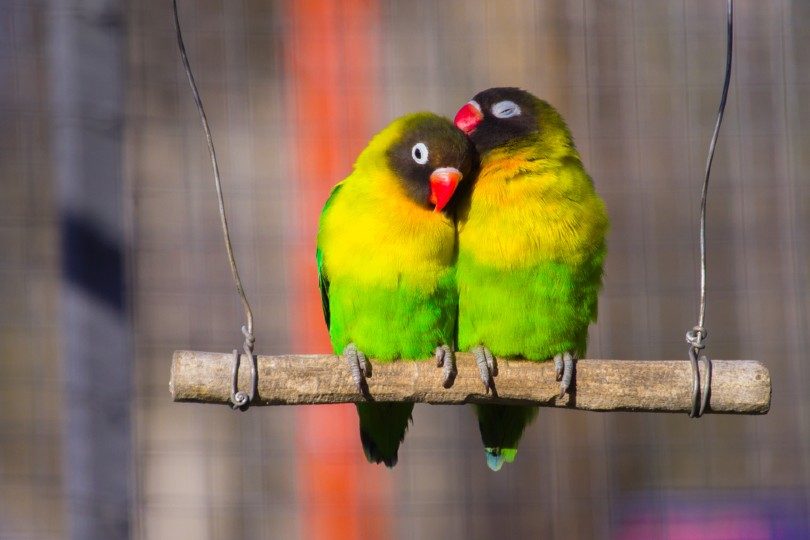
Cage
Birds are very territorial and need a lot of space in their cages. If you have a larger aviary or cage, you’ll increase your chances of keeping multiple species. When you crowd the birds, there is increased aggression, and most of them will attack to protect their territories.
Whether they have the same personality or come in a similar size, it’s usually much safer to put birds from different species in separate cages. By doing this, you’ll manage your pet birds better with less stress, and they won’t hurt each other.
Suppose you want to socialize them; you have to give the older bird time to get used to the new bird. The best way is to avoid introducing a new bird into the existing cage.
Start with multiple cages placed at a distance but where they can view each other. You can then introduce the birds gradually in a neutral space outside their cages.
As you increase the time they spend together, you can determine whether they have a chance of getting along. Once they become accustomed to each other, you can now place them in one cage. To make this process seamless, you should carefully supervise their interactions.
Companionship Needs
A cockatiel is very social and requires companionship. Therefore, when you plan to introduce a lovebird, you still need to give both equal attention. Otherwise, they’ll start acting out.
 Summary
Summary
Cockatiels and lovebirds make excellent pets. However, due to their distinct temperaments and personalities, it might be challenging to place them in one cage.
They both require enough space to play without losing their territory. If you are planning to keep these two birds, consider getting a large aviary or different cages for peaceful coexistence.
Featured mage Credit by: Left – Cockatiel (giovannistrapazzon, Pixabay) Right – Lovebird (Alexas_Fotos, Pixabay)
 Lovebirds
Lovebirds Cockatiels
Cockatiels




